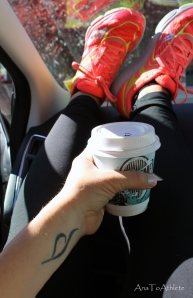So they say the number 13 is unlucky – I don’t consider myself a particularly superstitious person but perhaps that will change after this! I would like to turn my bad luck into fortune so here is my best spin on the current predicament I am in.
In just under 24 hours I will have surgery on my foot to bone graft and fixate a stress fracture which I somehow managed to get some time around Busselton Ironman last year (almost 8 months ago). How it all came about is a story for another day but the gist of it is, this will be stress fracture number 13 for me.
13 sounds like a lot but I will qualify it by putting things into some kind of context: the first 10 were all sustained during “the Ana years”, so when you work it out that’s averaging one a year during a period where I was running competitively as a distance runner (50-120km/week from age 12-22) and not eating much at all.
The last 3 stress fractures have been more “normal” athlete injuries, for one of a better description. That is, they have occurred predominantly due to training errors on my part, and have occurred over the last 7 years of being a healthy-weight competitive Ironman athlete. I have to add that with my personality type (ie a “Pleaser” and Type-A overachiever), being a Physio doesn’t really help with coaching errors – what the coach writes, I do, no questions asked. That part of my brain that analyses injures for a living doesn’t really factor in much when I am training (that isn’t work time, that’s my fun time!) and unfortunately it’s something I still need to work on in the future to prevent more injuries. While those down times have never been easy – time away from my love, running is always trying – in the past I have always managed to heal pretty well and been able to cross train through them.
Not this time.
Unfortunately this time the fracture was in a tiny bone under your foot called the sesamoid; it has terrible blood flow and so is notorious for being a slow healer. So, despite the 8 mandatory weeks in a boot, the use of bone stim, good nutrition and now over 7 months away from running, it hasn’t healed.
This left me calling for a little help from my friends, who fortunately include a couple of top Sports Physicians and Orthopaedic surgeons. At this point we were left with 3 options: 1) Remove the bone and hope for the best, which would likely include not a lot of running in my future; 2) Go back in the boot for 12 weeks, then operate after if it hadn’t healed – avoids surgery but not a great long-term outcome; or 3) to graft some healthy bone into my sesamoid and stick a screw in there to fix it in place. This would give me a 90% chance of being back to running in 9 months, and back to Ironman training in 12, and the best long-term outcome regarding risk of re-injury. For the medical nerds out there, the surgeon will also do a 1st metatarsal dorsiflexion osteotomy at the same time to unload the joint permanently.
So, this leads us to the now. Granted, a week before major orthopaedic surgery would seem a strange time to start up a blog but for this little black duck, the timing couldn’t be better. Over the coming weeks I will have forced “down time”, allowing me to get some writing done, but more importantly the next few months are going to be quite challenging. What better opportunity to write about how to best handle it using strategies I have learnt over the last 7 years. My hope is that in the process I can help a lot of people out there – because while I am certain my predicament is unique, I’m just as certain many of you have been through similar challenges (or may face them in the future). I do know that one thing athletes are great at is talking a lot when things are going well, then going into a black shadow when they aren’t racing or training well. There have been many times in the past when I wish that I could have had some advice about how to cope with injuries – mentally, not physically – from the athletes out there, and so I am going to start a trend: talking about it. You can help by joining in the conversation and firing away with any questions or topics you might like covered. I will do my best to entertain and enlighten!
So, wish me luck, and see you on the other side! Hoping I can make 13 into my lucky number – I thoroughly believe everything happens for a reason.
Any questions or comments fire away.
Happy training!
K xo





